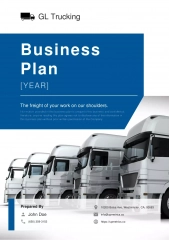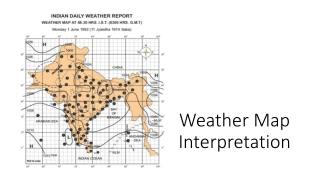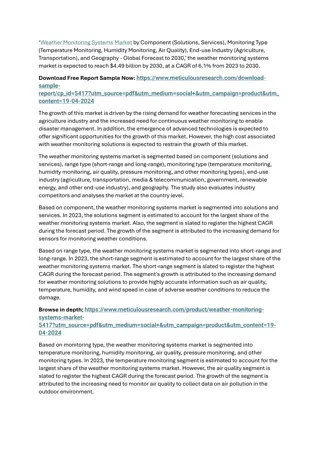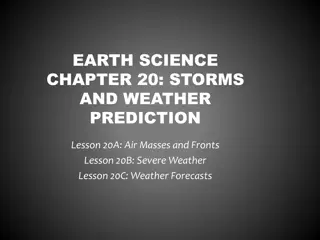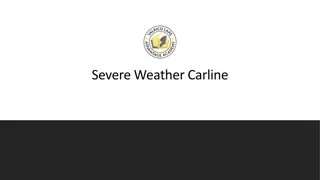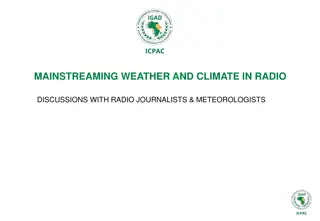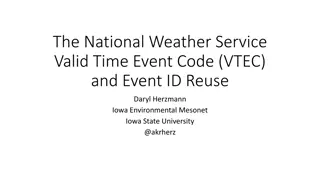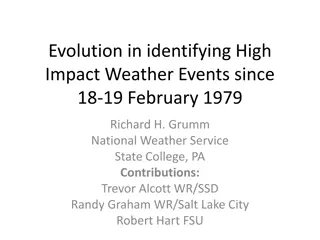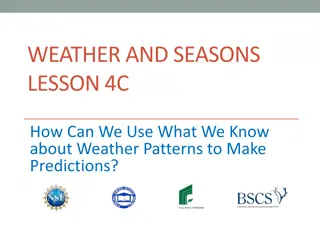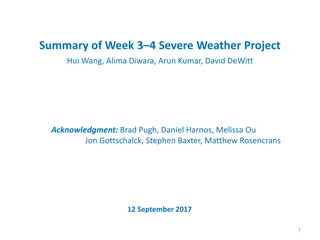
Managing Weather Challenges in Trucking Operations
Efficiently navigating weather challenges is crucial for smooth trucking operations. Understanding time zones, meteorological seasons, and major weather culprits like snow, ice, rain, and high winds is essential for ensuring timely deliveries, minimizing delays, and prioritizing driver safety.
Download Presentation

Please find below an Image/Link to download the presentation.
The content on the website is provided AS IS for your information and personal use only. It may not be sold, licensed, or shared on other websites without obtaining consent from the author. If you encounter any issues during the download, it is possible that the publisher has removed the file from their server.
You are allowed to download the files provided on this website for personal or commercial use, subject to the condition that they are used lawfully. All files are the property of their respective owners.
The content on the website is provided AS IS for your information and personal use only. It may not be sold, licensed, or shared on other websites without obtaining consent from the author.
E N D
Presentation Transcript
Understanding time zones is essential, especially when coordinating appointments for your trucks and tracking shipments. It ensures timely deliveries, minimizes scheduling conflicts, and enhances communication with clients or partners in different regions.
This map highlights U.S. weather patterns by dividing the country into nine regions. It helps to identify areas impacted by hurricanes, fires, or tornadoes key for effective planning, providing accurate updates and estimating arrival times more effectively.
THE METEOROLOGICAL SEASONS Meteorological Spring in the Northern Hemisphere includes March, April, and May. Meteorological Fall includes September, October, and November. Meteorological Winter includes December, January, and February. Meteorological Summer includes June, July, and August.
SNOW AND ICE RAIN HIGH WINDS Accounting for more than 50% of all weather-related traffic delays, snow and ice have a big impact on mobility and visibility for truckers and others on the road. Meteorological winter includes December, January, and February. Heavy rains are another huge obstacle to visibility, cutting a trucker s speed down by 25%. In fact, 46% of wrecks take place during periods of heavy rain. Typically, monsoon season is the months of July, August, and September. That's when afternoon thunderstorms are most frequent and severe. A big issue in the western states, high winds can create a variety of hazards for truckers, including harmful debris blowing into the road. Additionally, high winds can impact the stability of trucks, resulting in speed reductions and even accidents.
MAJOR WEATHER CULPRITS FOR the Trucking Industry Natural Disasters like hurricanes, blizzards, tornadoes, and floods, shut down roads, leaving goods to be stranded for days. These delays can result in up to $100 million a day in losses. In the Northern Atlantic Ocean, September is the most active - a distinct hurricane season occurs from June to November, sharply peaking from late August through September. Tornadoes can form at any time of year, but most occur in the spring and summer months along with thunderstorms. May and June are usually the peak months for tornadoes. Extreme Heat can also cause delays for a trucker and potential issues in cargo quality. Driver capability, vehicle performance, pavement friction, roadway infrastructure, and traffic flow can all be negatively impacted by high heat. In dealing with all these kinds of weather, safety for the drivers and others on the road should be trucking companies and shippers highest priority. This includes supporting trucking companies and truckers in proper safety standards as well as weather and emergency preparedness. For most of the country, the warmest day occurs sometime between mid-July and mid-August.
GUARANTEES AND EXPEDITED SHIPPING POWER OUTAGES CAPACITY LIMITATIONS Severe weather or natural disasters can disrupt normal operations by reducing truck availability. Traffic jams from snow or flooding, or rerouted drivers, take trucks out of the capacity pool. Even if a storm doesn t directly impact a customer, it can still affect carrier options and rates. Power outages from extreme weather events like hurricanes, tornadoes, or blizzards can disrupt freight operations by damaging infrastructure, communication, and limiting access to fuel. To address this, we use advanced TMS to track shipments and monitor weather conditions, customers stay informed in any situation. Guaranteed or expedited shipping adds cost but shipment. However, severe weather can still disrupt transit times. Staying aware of weather conditions along the route helps manage expectations for delivery. prioritizes your cutting ensuring our
ROAD CONDITIONS TERMINALS Freight terminals and roads may close or operate at limited capacity during severe weather to ensure the safety of the facility and its workers. Limited operations mean some shipments may still go out, but delays are likely. Full closures occur when conditions are too dangerous for staff to work or for trucks to travel safely. Flooding or heavy snow can lead to road closures, requiring alternate routes and extending transit times. While delays are frustrating, safety is the priority for both truckers and your freight. Driving an 18-wheeler with poor visibility, traction issues, and challenging, making cautious decisions essential to protect both the shipment and the driver. hazardous roads is

